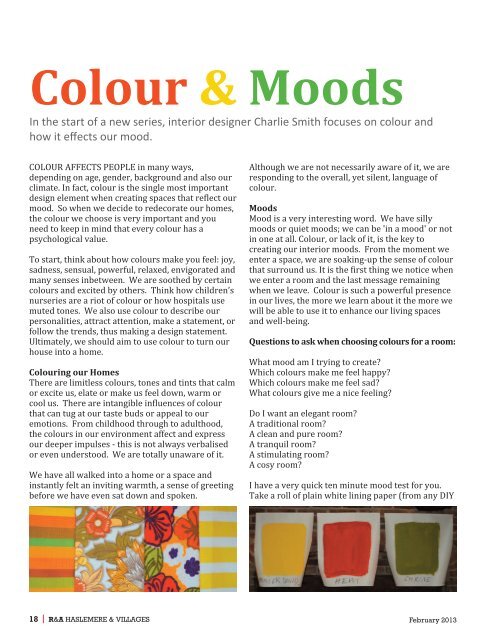View as a PDF - Round & About Magazine
View as a PDF - Round & About Magazine
View as a PDF - Round & About Magazine
Create successful ePaper yourself
Turn your PDF publications into a flip-book with our unique Google optimized e-Paper software.
Colour & Moods<br />
In the start of a new series, interior designer Charlie Smith focuses on colour and<br />
how it effects our mood.<br />
COLOUR AFFECTS PEOPLE in many ways,<br />
depending on age, gender, background and also our<br />
climate. In fact, colour is the single most important<br />
design element when creating spaces that reflect our<br />
mood. So when we decide to redecorate our homes,<br />
the colour we choose is very important and you<br />
need to keep in mind that every colour h<strong>as</strong> a<br />
psychological value.<br />
To start, think about how colours make you feel: joy,<br />
sadness, sensual, powerful, relaxed, envigorated and<br />
many senses inbetween. We are soothed by certain<br />
colours and excited by others. Think how children’s<br />
nurseries are a riot of colour or how hospitals use<br />
muted tones. We also use colour to describe our<br />
personalities, attract attention, make a statement, or<br />
follow the trends, thus making a design statement.<br />
Ultimately, we should aim to use colour to turn our<br />
house into a home.<br />
Colouring our Homes<br />
There are limitless colours, tones and tints that calm<br />
or excite us, elate or make us feel down, warm or<br />
cool us. There are intangible influences of colour<br />
that can tug at our t<strong>as</strong>te buds or appeal to our<br />
emotions. From childhood through to adulthood,<br />
the colours in our environment affect and express<br />
our deeper impulses - this is not always verbalised<br />
or even understood. We are totally unaware of it.<br />
We have all walked into a home or a space and<br />
instantly felt an inviting warmth, a sense of greeting<br />
before we have even sat down and spoken.<br />
18 x R&A HASLEMERE & VILLAGES<br />
Although we are not necessarily aware of it, we are<br />
responding to the overall, yet silent, language of<br />
colour.<br />
Moods<br />
Mood is a very interesting word. We have silly<br />
moods or quiet moods; we can be 'in a mood' or not<br />
in one at all. Colour, or lack of it, is the key to<br />
creating our interior moods. From the moment we<br />
enter a space, we are soaking-up the sense of colour<br />
that surround us. It is the first thing we notice when<br />
we enter a room and the l<strong>as</strong>t message remaining<br />
when we leave. Colour is such a powerful presence<br />
in our lives, the more we learn about it the more we<br />
will be able to use it to enhance our living spaces<br />
and well-being.<br />
Questions to <strong>as</strong>k when choosing colours for a room:<br />
What mood am I trying to create?<br />
Which colours make me feel happy?<br />
Which colours make me feel sad?<br />
What colours give me a nice feeling?<br />
Do I want an elegant room?<br />
A traditional room?<br />
A clean and pure room?<br />
A tranquil room?<br />
A stimulating room?<br />
A cosy room?<br />
I have a very quick ten minute mood test for you.<br />
Take a roll of plain white lining paper (from any DIY<br />
February 2013







